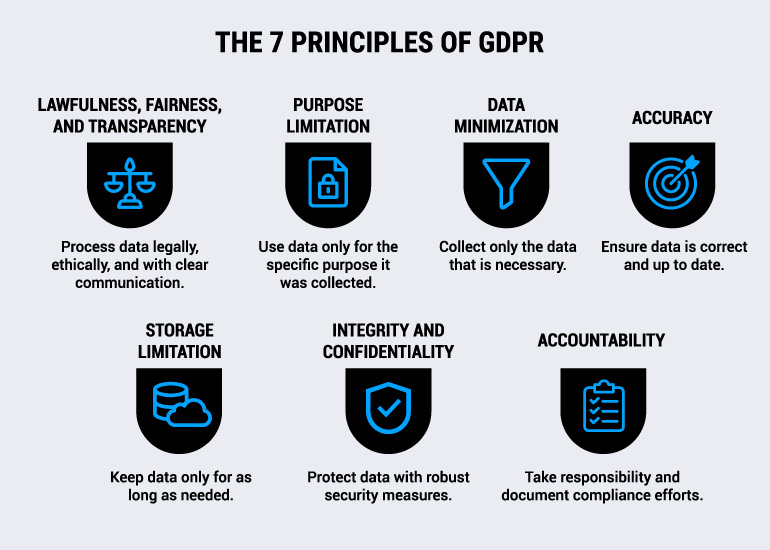The General Data Protection Regulation (GDPR) set an international standard for how organizations collect, process, and store personal data. Organizations under its jurisdiction need to comply in order to minimize legal risk, protect operations, and maintain trust in the world’s most highly regulated markets.
But GDPR compliance has become more complicated since Brexit. The UK retained the GDPR framework when it left the EU, but adapted some aspects to fit its own legal context. Additional legislation has been passed, such as the Data (Use and Access) Act 2025, which will further differentiate the UK GDPR from the EU version.
While the two laws remain closely aligned, they have differences that can cause some uncertainty about responsibilities and compliance requirements.
This article provides a UK GDPR vs EU GDPR comparison. We discuss the similarities and differences between the two laws, highlight recent developments, and offer practical guidance on how to achieve and maintain compliance with both.
Key takeaways
- The EU GDPR and UK GDPR are closely aligned data protection laws for separate regions that safeguard individuals’ personal information through shared core principles.
- The EU GDPR applies to any organization processing data of EU or EEA residents, while the UK GDPR governs data belonging to individuals in England, Scotland, Wales, and Northern Ireland.
- Both frameworks preserve data subject rights, including access, erasure, rectification, and portability.
- The UK GDPR, influenced by the Data (Use and Access) Act, introduces updates such as a new “recognized legitimate interest” basis and relaxed rules around automated decision-making.
- To meet compliance requirements in both jurisdictions, businesses should regularly review data adequacy decisions, update transfer contracts, and use a CMP to automate region-specific consent requirements.
What is the EU GDPR?
The EU GDPR is the European Union’s primary data protection regulation. It came into force in 2018 to protect individuals’ data and privacy with a consistent legal framework.
The law governs how organizations with customers and users located in GDPR countries monitor those individuals, and/or collect, process, and store personal data. It’s based on core principles like transparency and accountability.
This law also establishes rights for data subjects, which give them control over how businesses access and manage their information. As a data controller or processor, it’s your responsibility to prove that you uphold these rights to demonstrate compliance.
When does the EU GDPR apply?
The EU GDPR applies to any organization that collects, manages, or stores the personal data of individuals, or monitors their behavior, within any of the 27 EU Member States or the three European Economic Area (EEA) countries. This includes controllers, which decide how to use information, as well as any processors that act on their behalf.
Business location is irrelevant to the EU GDPR. If your business is based in the United States, for example, you must still comply with the regulation if you sell goods to customers in France. That’s because even though you operate outside of the EU, you’re still collecting personal data from EU residents, like addresses and payment details.
What is the UK GDPR?
The UK GDPR is the UK’s primary data protection law. It’s the country’s domestic version of the original EU GDPR. It was incorporated through the UK Data Protection Act when the country left the European Union, and came into effect January 1, 2021.
Establishing the UK GDPR has enabled the country to continue to uphold individual rights and protections after Brexit. It carried over many data protection principles from the EU GDPR. However, separating from the EU has given the UK the freedom to instate its own supervisory authority and adapt the laws to its own needs.
When does the UK GDPR apply?
Similar to the EU, the UK GDPR applies to any organization that processes the personal data of individuals located in England, Scotland, Wales, and Northern Ireland. The law applies regardless of where your company is based.
For instance, an Australian tech company offering subscriptions to UK-based users would need to comply because it collects personal information like names and emails.
Is there a difference between the EU GDPR and UK GDPR?
There are meaningful differences between the two versions of the GDPR, especially with the introduction of the UK’s Data (Use and Access) Act (DUAA), which amends the UK GDPR. That law will come into effect in stages, expected to be at two, six and 12 months after royal assent, which was granted on June 19, 2025.
Here’s a brief side-by-side overview of the two regulations.
| Regulation | EU GDPR | UK GDPR |
| Supervisory authority | National data protection authorities (DPA) in each member state, coordinated by the European Data Protection Board (EDPB) | The Information Commissioner’s Office (ICO) |
| Legal bases for processing | Six: Consent, contractual obligation, legal obligation, vital interests of the data subject, public interest, or legitimate business interest | Six (with a seventh proposed): Consent, contractual obligation, legal obligation, vital interests of the data subject, public interest, legitimate business interest, and recognized legitimate interest (proposed) |
| Age of consent | 16 | 13 |
| Data transfers | Free-flowing data transfers permitted to EU Member States and third-party countries with data adequacy decisions | Free-flowing data transfers permitted within the UK and to third-party countries with data adequacy decisions |
| Fines and penalties | Tiered, up to EUR 20 million or four percent of total global turnover, whichever is higher | Tiered, up to GBP 17.5 million or four percent of total global turnover, whichever is higher |
Additional information about the EU GDPR and UK GDPR differences
Recognized legitimate interest
Both frameworks provide six lawful bases for processing data. The UK government is planning to add a seventh basis known as “recognized legitimate interest” sometime in 2026 that would enable businesses to process data for reasons such as crime prevention or security, without requiring balancing tests.
Automated decision-making
Previously, both versions limited automated decision-making to cases where businesses have collected consent or made a contract. The DUAA relaxes certain rules of the UK GDPR to permit businesses to rely on the full range of legal bases, provided they have adequate safeguards in place.
Cookie use and consent
GDPR cookies require informed, explicit consent, which is the same under the UK GDPR. Information obtained via cookie use is considered personal information, so consent is required for processing. However, under the DUAA, the UK GDPR authorizes the use of storage and access technologies without explicit consent in specific low-risk situations.
One-Stop-Shop (OSS)
The One-Stop-Shop or OSS mechanism permits companies with data processing operations spread across multiple Member States to work with a single Supervisory Authority. Because the UK left the EU, businesses active in both regions must engage with the ICO and country-specific EU DPAs individually.
Stop the clock
Both versions of the GDPR give organizations one month to respond to data subject access requests (DSARs), and both grant extra time for complex cases. The key difference is that the UK DUAA provides a “stop the clock” provision if organizations need more time to gather information from the requester, whereas the EU only permits extensions for exceptional cases.
What is the same between the EU GDPR and UK GDPR?
Because the UK GDPR kept the same basic framework from the EU GDPR, the laws have more similarities than differences. Here’s where the EU and the UK law overlap.
Core GDPR principles
Both versions of the GDPR are based on the same seven principles. These embody the intention of the laws and give your business values to guide your practices.
- Lawfulness, fairness, and transparency: Process data in a legal, ethical way that is easy for users to understand.
- Data minimization: Only collect the information you need to fulfill your stated purpose.
- Purpose limitation: Only use data for the specific reason for which it was originally collected. New purposes require new consent.
- Accuracy: Keep information correct and up to date.
- Storage limitation: Only keep data for as long as needed to fulfill its original purpose.
- Integrity and confidentiality: Protect data from unauthorized access, loss, or damage.
- Accountability: Demonstrate that you uphold these principles in practice.
What’s more, your organization must document efforts to uphold data subject rights in order to demonstrate GDPR compliance.

Data subject rights
Both the EU and UK GDPR give individuals the same rights over their personal data:
- Right to be informed about how you use their data
- Right to access a copy of their personal data
- Right to rectify data that is inaccurate or incomplete
- Right to erasure, or to have their data deleted
- Right to restrict processing
- Right to withdraw consent
- Right to data portability, or to receive a copy of their data to transfer elsewhere safely and securely
- Rights related to automated decision-making and profiling, including being able to object to automated decision-making
Data Protection Officers (DPOs)
Both versions of the regulation require businesses to appoint a Data Protection Officer (DPO) to oversee data processing activities and manage compliance in certain cases, such as when a business engages in large-scale processing of sensitive data or systematic monitoring of individuals.
While the UK government debated replacing DPOs with a Senior Responsible Individual (SRI), the Data Protection and Digital Information Bill, in which it’s included, has yet to be passed into law.
Basic terminology
The EU and UK GDPR still use the same key terminology. For example, they both broadly define personal data as any information that can identify an individual, either directly or indirectly. This consistency makes it easier for your business to interpret and understand the different sets of regulatory requirements.
Data adequacy
Both the EU and the UK use adequacy decisions to permit international data transfers without additional safeguards. These rulings confirm that another country’s privacy laws provide a comparable level of protection to their own. As of 2025, the EU and UK have adequacy decisions with each other and the same 14 countries.
These rulings are subject to periodic review, so you must stay continuously updated. If any of the regions where you transfer data is no longer deemed to have an adequate level of protection, you’ll need to start using extra safeguards.
Compliance and consent recommendations: Best practices for both regulations
Given the subtle differences between the two versions of the GDPR, how can you comply with both and minimize the risk of penalties? Here are some tips for achieving compliance even as regulations continue to diverge:
- Review adequacy decisions: Regularly verify the adequacy decisions for all jurisdictions where you transfer data. That way, you can react quickly if either the UK or the EU changes a ruling.
- Update transfer contracts: Confirm that any contracts you use for cross-border data transfers use the latest approved safeguards — standard contractual clauses (SCCs) for the EU and international data transfer agreements (IDTAs) for the UK.
- Update cookie banners: Adapt your website banners and notices to reflect each framework’s requirements. While the UK’s new flexible rules allow you to automatically enable more types of cookies without consent, doing so doesn’t align with requirements under the EU GDPR.
- Meet GDPR consent requirements with compliance automation: Use a consent management platform (CMP) to automatically detect each user’s location and apply safeguards and consent banners accordingly. Solutions like the Usercentrics CMPs support both versions of the GDPR to help you achieve multi-regulation compliance.
- Appoint UK and EU representatives: If you’re based outside these jurisdictions but process large amounts of data belonging to individuals located within them, appoint a local representative to liaise with regulators and handle DSARs. Doing so helps you achieve full coverage across all regions where you process data, avoiding compliance gaps.
Achieve multi-regulation compliance with Usercentrics
Global organizations need to understand both the UK GDPR and the EU GDPR to process data across regions. While the two laws are closely aligned, they are continuously updated and may gradually diverge, which means compliance requires ongoing attention.
The Usercentrics CMP simplifies multi-regulation data privacy compliance. Geolocation features adapt your site or app to local regulations in real time, so website consent banners and privacy policies stay updated to match the requirements of each user’s jurisdiction.
As Thomas Adelbauer, MediaShop’s Team Lead for Application & Data, says, “Usercentrics is a powerful CMP that helps us be GDPR-compliant. It’s easy to integrate and manage, and it gives our customers confidence that we only process their data with their consent.”

